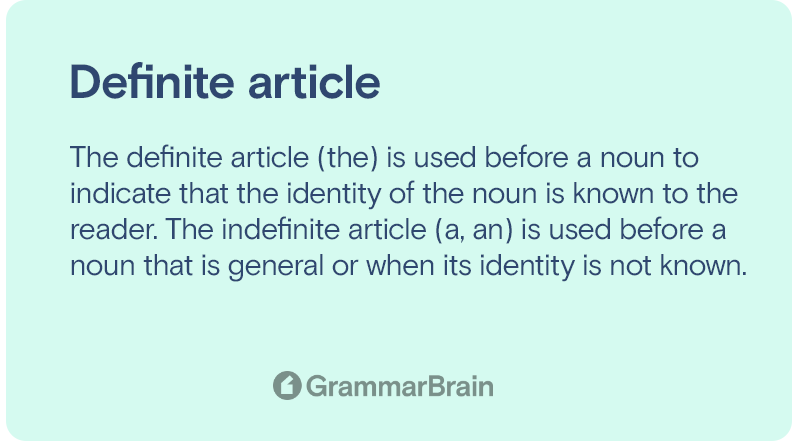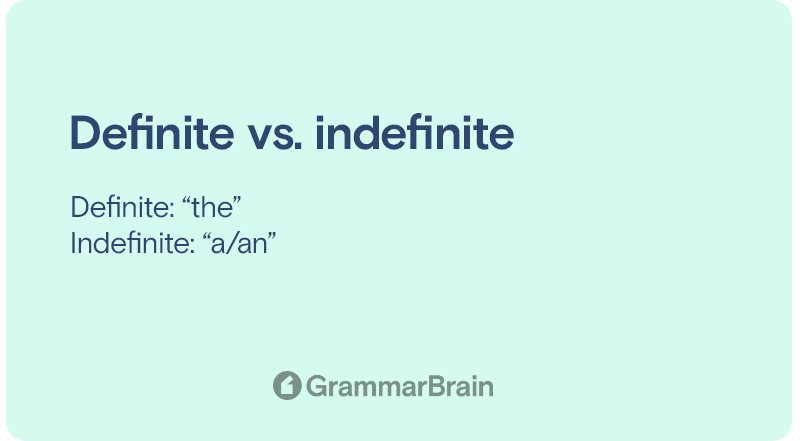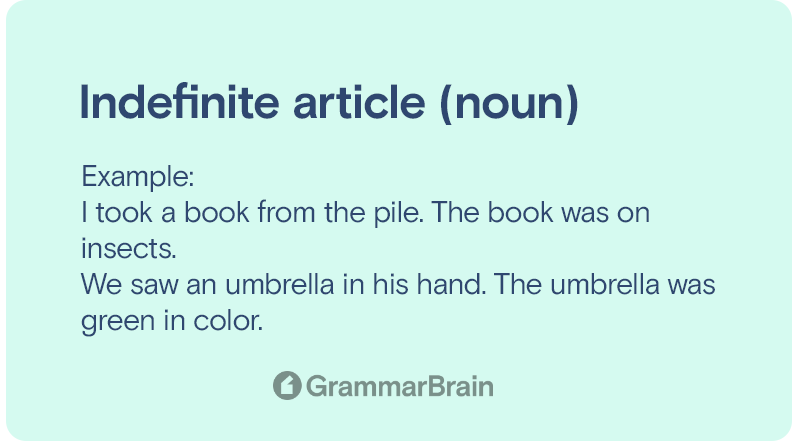What is an indefinite article? Before we dive deeper into the fascinating world of indefinite articles, we need to be well-prepared with what articles mean in the world of grammar. The following article will provide a crash course on articles, explicitly focusing on the indefinite form.

What are definite articles and indefinite articles (articles)?
An article is an important device that identifies a part of a speech as a noun (or something equivalent to it). It however does not serve the purpose of describing the noun (or noun equivalent).
There are two types of articles – definite and indefinite. Among these, ‘a’ and ‘an’ fall under the indefinite category, while ‘the’ falls under the definite category.
| Definite Articles | Indefinite Articles |
| The | A, an |
Examples of definite and indefinite articles
The following are examples of definite and indefinite articles.
- I made a peanut butter and jelly sandwich for breakfast.
- I boiled an egg for breakfast.
- I ate the pastry on the table.
In sentence 1, ‘a’ is the indefinite article. It identifies ‘peanut butter and jelly sandwich’ as the noun (or equivalent) without referring to any specific peanut butter and jelly sandwich.
In sentence 2, ‘an’ is an is the indefinite article that identifies ‘egg’ as the noun (or equivalent), without referring to any specific egg.
In sentence 3, ‘the’ is an is the definite article which identifies ‘pastry ’ as the noun (or equivalent), referring to the specific pastry on the table.
Let’s now get an in-depth idea of the indefinite articles ‘a’ and ‘an’ below.
Definition of an indefinite article
An indefinite article is instrumental in introducing a noun (or noun equivalent) without specifying it or putting it out there for the first time. It is used to refer to something non-specific or generic.

Examples of indefinite articles
The following are some examples to help you understand indefinite articles even better.
- Close a window.
Here, ‘a’ is the indefinite article that introduces a noun (window) without specifying any particular window. You can close any window in this case.
- Close the window.
Here, ‘the’ is the indefinite article that introduces a noun (window) by specifying a particular window. You have to close the particular window referred to in this case.
- I want an ice cream.
Here, ‘an’ is the indefinite article that introduces a noun (ice cream) without specifying any particular ice cream. You can provide any ice cream in this case.
- I want the ice cream.
Here, ‘the’ is the indefinite article that introduces a noun (ice cream) by specifying a particular ice cream. You have to provide the particular ice cream referred to in this case.

How does an indefinite article work?
This section will deal with the functioning of the indefinite articles ‘a’ and ‘an’. Let us discuss the two main roles that indefinite articles perform in a sentence. They are as follows:
Introducing the noun (or noun equivalent)
When a noun (or equivalent) is introduced, an indefinite article such as ‘a’ or ‘an’ is used to refer to it. After the primary introduction, the definite article ‘the’ can take over if we talk about something specific.
For example:
- I took a book from the pile. The book was on insects.
- We saw an umbrella in his hand. The umbrella was green in color.
In sentence 1, the indefinite article ‘a’ is used to introduce the noun (book), and the definite article ‘the’ is used to provide further details about the specific book.
In sentence 2, the indefinite article ‘an’ is used to introduce the noun (umbrella), and the definite article ‘the’ is used to provide further details about the specific umbrella.

Pointing to non-specific things
We do not always want to refer to specific objects. Sometimes, we talk about generic things whose details we either do not have or consider far too unnecessary or unimportant to provide. In such a scenario, indefinite articles come into handy.
A couple of examples will sort this out better for you, as provided below.
- My sister wants a kitten for her birthday this year. I will adopt a kitten from the local shelter instead of buying one for her.
- I added an apple to my shopping basket. The proverb that an apple a day keeps the doctor away still rings true.
How to identify an indefinite article
It is relatively easy to identify an indefinite article in a sentence. There are two indefinite articles – and an. The indefinite article ‘a’ is placed before nouns (or equivalents) starting with consonants.
The indefinite article ‘an’ is placed before nouns (or equivalents) starting with vowels.

The rules for identifying an indefinite article are as follows:
- Check that you place it before a singular count noun.
- Check that the specific identity of the noun is not known.
For example:
- A kitten was inside the basket.
- I peeled an orange.
Indefinite Article Exceptions
A and an are usually very easy to use. You have to look out whether the noun (or noun equivalent) after the article starts with a consonant or a vowel. However, there are some exceptions.
Examples of indefinite article exceptions
- I have a one-dollar note. (One starts with a consonant sound, almost like a W)
- I waited for an hour at the station. (Hour starts with a vowel sound, almost like an O)
Some other exceptions include:
- Useless, university, European, uniform (These words begin with a consonant Y sound and pair with a.)
- Honest, honor, heir, hotel (These words begin with a vowel O sound and pair with an.)
- Acronyms pair with ‘a’ or ‘an’ depending on how the words are pronounced.
Indefinite article vs. definite article
Indefinite articles deal with non-specific or generic nouns (or noun equivalents). Definite articles deal with specific nouns (or noun equivalents). A and an are indefinite articles, while the is a definite article.
For example:
FAQs
When to use “a” or “an?”
Use ‘a’ or ‘an’ for non-specific or generic nouns (or equivalents). Use ‘a’ for consonant nouns, while you can use ‘an’ for vowel nouns.
What is an indefinite article example?
An indefinite article example is:
- I bought a doll for my niece.
- I had an avocado sandwich for lunch.
Is it a unicorn or an?
Unicorn is an exception. Since the pronunciation of a unicorn starts with a Y sound (consonant), the indefinite article used here is a.
When should I apply the definite and indefinite article?
Apply the definite article before a singular or plural noun. And indefinite before a singular noun start with a consonant (vowel sounds). Using articles with singular nouns help the reader understand who we are referring to. Use the indefinite article “a” or “an” only with a singular count noun.
Inside this article
Fact checked:
Content is rigorously reviewed by a team of qualified and experienced fact checkers. Fact checkers review articles for factual accuracy, relevance, and timeliness. Learn more.
Core lessons
Glossary
- Abstract Noun
- Accusative Case
- Anecdote
- Antonym
- Active Sentence
- Adverb
- Adjective
- Allegory
- Alliteration
- Adjective Clause
- Adjective Phrase
- Ampersand
- Anastrophe
- Adverbial Clause
- Appositive Phrase
- Clause
- Compound Adjective
- Complex Sentence
- Compound Words
- Compound Predicate
- Common Noun
- Comparative Adjective
- Comparative and Superlative
- Compound Noun
- Compound Subject
- Compound Sentence
- Copular Verb
- Collective Noun
- Colloquialism
- Conciseness
- Consonance
- Conditional
- Concrete Noun
- Conjunction
- Conjugation
- Conditional Sentence
- Comma Splice
- Correlative Conjunction
- Coordinating Conjunction
- Coordinate Adjective
- Cumulative Adjective
- Dative Case
- Determiner
- Declarative Sentence
- Declarative Statement
- Direct Object Pronoun
- Direct Object
- Diction
- Diphthong
- Dangling Modifier
- Demonstrative Pronoun
- Demonstrative Adjective
- Direct Characterization
- Definite Article
- Doublespeak
- False Dilemma Fallacy
- Future Perfect Progressive
- Future Simple
- Future Perfect Continuous
- Future Perfect
- First Conditional
- Irregular Adjective
- Irregular Verb
- Imperative Sentence
- Indefinite Article
- Intransitive Verb
- Introductory Phrase
- Indefinite Pronoun
- Indirect Characterization
- Interrogative Sentence
- Intensive Pronoun
- Inanimate Object
- Indefinite Tense
- Infinitive Phrase
- Interjection
- Intensifier
- Infinitive
- Indicative Mood
- Participle
- Parallelism
- Prepositional Phrase
- Past Simple Tense
- Past Continuous Tense
- Past Perfect Tense
- Past Progressive Tense
- Present Simple Tense
- Present Perfect Tense
- Personal Pronoun
- Personification
- Persuasive Writing
- Parallel Structure
- Phrasal Verb
- Predicate Adjective
- Predicate Nominative
- Phonetic Language
- Plural Noun
- Punctuation
- Punctuation Marks
- Preposition
- Preposition of Place
- Parts of Speech
- Possessive Adjective
- Possessive Determiner
- Possessive Case
- Possessive Noun
- Proper Adjective
- Proper Noun
- Present Participle
- Prefix
- Predicate



